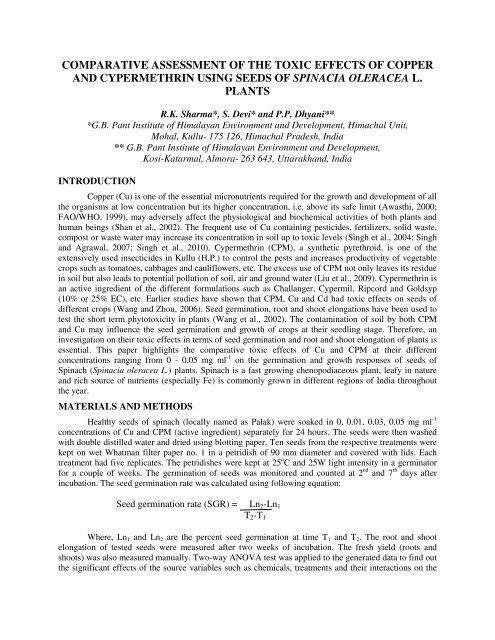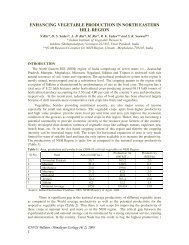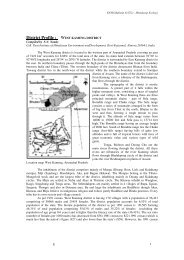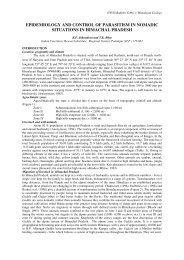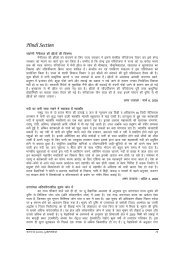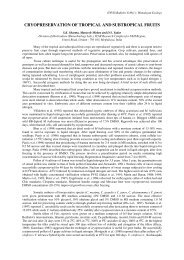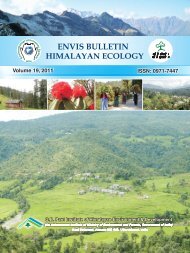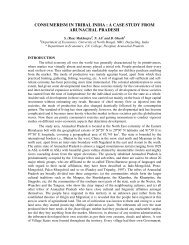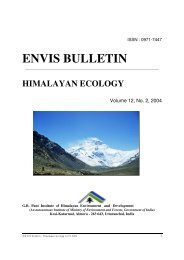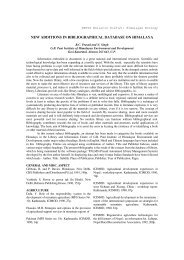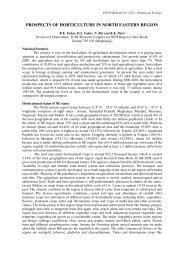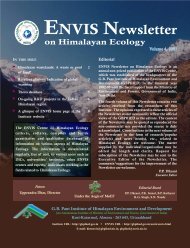comparative assessment of the toxic effects of copper and ...
comparative assessment of the toxic effects of copper and ...
comparative assessment of the toxic effects of copper and ...
- No tags were found...
You also want an ePaper? Increase the reach of your titles
YUMPU automatically turns print PDFs into web optimized ePapers that Google loves.
COMPARATIVE ASSESSMENT OF THE TOXIC EFFECTS OF COPPERAND CYPERMETHRIN USING SEEDS OF SPINACIA OLERACEA L.PLANTSR.K. Sharma*, S. Devi* <strong>and</strong> P.P. Dhyani***G.B. Pant Institute <strong>of</strong> Himalayan Environment <strong>and</strong> Development, Himachal Unit,Mohal, Kullu- 175 126, Himachal Pradesh, India** G.B. Pant Institute <strong>of</strong> Himalayan Environment <strong>and</strong> Development,Kosi-Katarmal, Almora- 263 643, Uttarakh<strong>and</strong>, IndiaINTRODUCTIONCopper (Cu) is one <strong>of</strong> <strong>the</strong> essential micronutrients required for <strong>the</strong> growth <strong>and</strong> development <strong>of</strong> all<strong>the</strong> organisms at low concentration but its higher concentration, i.e. above its safe limit (Awasthi, 2000;FAO/WHO, 1999), may adversely affect <strong>the</strong> physiological <strong>and</strong> biochemical activities <strong>of</strong> both plants <strong>and</strong>human beings (Shan et al., 2002). The frequent use <strong>of</strong> Cu containing pesticides, fertilizers, solid waste,compost or waste water may increase its concentration in soil up to <strong>toxic</strong> levels (Singh et al., 2004; Singh<strong>and</strong> Agrawal, 2007; Singh et al., 2010). Cypermethrin (CPM), a syn<strong>the</strong>tic pyrethroid, is one <strong>of</strong> <strong>the</strong>extensively used insecticides in Kullu (H.P.) to control <strong>the</strong> pests <strong>and</strong> increases productivity <strong>of</strong> vegetablecrops such as tomatoes, cabbages <strong>and</strong> cauliflowers, etc. The excess use <strong>of</strong> CPM not only leaves its residuein soil but also leads to potential pollution <strong>of</strong> soil, air <strong>and</strong> ground water (Liu et al., 2009). Cypermethrin isan active ingredient <strong>of</strong> <strong>the</strong> different formulations such as Challanger, Cypermil, Ripcord <strong>and</strong> Goldsyp(10% or 25% EC), etc. Earlier studies have shown that CPM, Cu <strong>and</strong> Cd had <strong>toxic</strong> <strong>effects</strong> on seeds <strong>of</strong>different crops (Wang <strong>and</strong> Zhou, 2006). Seed germination, root <strong>and</strong> shoot elongations have been used totest <strong>the</strong> short term phyto<strong>toxic</strong>ity in plants (Wang et al., 2002). The contamination <strong>of</strong> soil by both CPM<strong>and</strong> Cu may influence <strong>the</strong> seed germination <strong>and</strong> growth <strong>of</strong> crops at <strong>the</strong>ir seedling stage. Therefore, aninvestigation on <strong>the</strong>ir <strong>toxic</strong> <strong>effects</strong> in terms <strong>of</strong> seed germination <strong>and</strong> root <strong>and</strong> shoot elongation <strong>of</strong> plants isessential. This paper highlights <strong>the</strong> <strong>comparative</strong> <strong>toxic</strong> <strong>effects</strong> <strong>of</strong> Cu <strong>and</strong> CPM at <strong>the</strong>ir differentconcentrations ranging from 0 - 0.05 mg ml -1 on <strong>the</strong> germination <strong>and</strong> growth responses <strong>of</strong> seeds <strong>of</strong>Spinach (Spinacia oleracea L.) plants. Spinach is a fast growing chenopodiaceous plant, leafy in nature<strong>and</strong> rich source <strong>of</strong> nutrients (especially Fe) is commonly grown in different regions <strong>of</strong> India throughout<strong>the</strong> year.MATERIALS AND METHODSHealthy seeds <strong>of</strong> spinach (locally named as Palak) were soaked in 0, 0.01, 0.03, 0.05 mg ml -1concentrations <strong>of</strong> Cu <strong>and</strong> CPM (active ingredient) separately for 24 hours. The seeds were <strong>the</strong>n washedwith double distilled water <strong>and</strong> dried using blotting paper. Ten seeds from <strong>the</strong> respective treatments werekept on wet Whatman filter paper no. 1 in a petridish <strong>of</strong> 90 mm diameter <strong>and</strong> covered with lids. Eachtreatment had five replicates. The petridishes were kept at 25 o C <strong>and</strong> 25W light intensity in a germinatorfor a couple <strong>of</strong> weeks. The germination <strong>of</strong> seeds was monitored <strong>and</strong> counted at 2 nd <strong>and</strong> 7 th days afterincubation. The seed germination rate was calculated using following equation:Seed germination rate (SGR) = Ln 2 -Ln 1T 2 -T 1Where, Ln 1 <strong>and</strong> Ln 2 are <strong>the</strong> percent seed germination at time T 1 <strong>and</strong> T 2 . The root <strong>and</strong> shootelongation <strong>of</strong> tested seeds were measured after two weeks <strong>of</strong> incubation. The fresh yield (roots <strong>and</strong>shoots) was also measured manually. Two-way ANOVA test was applied to <strong>the</strong> generated data to find out<strong>the</strong> significant <strong>effects</strong> <strong>of</strong> <strong>the</strong> source variables such as chemicals, treatments <strong>and</strong> <strong>the</strong>ir interactions on <strong>the</strong>
tested parameters. Duncan’s multiple range test (DMRT) was fur<strong>the</strong>r applied to <strong>the</strong> data to test <strong>the</strong>significant differences between <strong>the</strong> treatment means.RESULTS AND DISCUSSIONThe results showed that seed germination decreased significantly with increasing concentrations<strong>of</strong> both <strong>the</strong> CPM <strong>and</strong> Cu (Fig. 1). The reduction in seed germination was recorded maximum at 0.05 mgml -1 treatment <strong>of</strong> both Cu <strong>and</strong> CPM (36% <strong>and</strong> 59%, respectively). The <strong>toxic</strong> <strong>effects</strong> <strong>of</strong> CPM on seedgermination was found more as compared to Cu (R 2 = -0.93, p
Fig. 3 Effects <strong>of</strong> chemical treatments (0-0.05 mg ml -1 ) on fresh yield <strong>of</strong> seedlings <strong>of</strong> S. oleracea L. Bars are mean ±SE <strong>of</strong> five replicates. Bars <strong>of</strong> respective treatment followed by different letters are significantly different from eacho<strong>the</strong>r at p≤0.05 (Duncan’s multiple range test).The results <strong>of</strong> two-way ANOVA test clearly showed that chemicals, treatments <strong>and</strong> chemicals ×treatments have significant <strong>effects</strong> on all <strong>the</strong> tested parameters <strong>of</strong> plant growth (Table 1). However,interaction <strong>of</strong> variables <strong>and</strong> chemicals did not show significant <strong>effects</strong> on shoot <strong>and</strong> root elongation. Thisstudy also suggests that <strong>the</strong> sources <strong>of</strong> variables <strong>and</strong> <strong>the</strong>ir interaction may affect <strong>the</strong> growth <strong>and</strong>development <strong>of</strong> seedlings <strong>of</strong> spinach plants. This study concludes that presence <strong>of</strong> CPM <strong>and</strong> Cu in soilmay influence <strong>the</strong> seed germination, PSG, SGR <strong>and</strong> growth <strong>of</strong> seedlings <strong>of</strong> a crop. The study fur<strong>the</strong>rreveals that CPM has more <strong>toxic</strong> <strong>effects</strong> on seeds <strong>of</strong> S. oleracea L. as compared to Cu, <strong>and</strong> <strong>toxic</strong> effect orsoil pollutants on food crops needs to be studied fur<strong>the</strong>r.Table 1: Results <strong>of</strong> two-way ANOVA test F-values (significance levels) for <strong>the</strong> tested parameters <strong>of</strong> S. oleraceaL. seeds.ParametersSources <strong>of</strong> VariationChemicals (C) Treatments (T) C × TPSG 46.10 (***) 96.70 (***) 6.12 (**)SGR 13.98 (**) 29.75 (***) 1.24 (ns)Root elongation 0.13 (ns) 43.60 (***) 7.31(**)Shoot elongation 4.47 (*) 17.68 (***) 1.05 (ns)Total yield 158.16 (***) 105.23 (***) 3.54 (*)Levels <strong>of</strong> significance; ***P
Singh, K.P., Mohon, D., Sinha, S. <strong>and</strong> Dalwani, R. 2004. Impact <strong>assessment</strong> <strong>of</strong> treated/ untreatedwastewater <strong>toxic</strong>ants discharge by sewage treatment plants on health, agricultural <strong>and</strong>environmental quality in wastewater disposal area. Chemos 55: 227–255.Singh, R.P. <strong>and</strong> Agrawal, M. 2007. Effects <strong>of</strong> sewage sludge amendment on heavy metal accumulation<strong>and</strong> consequent responses <strong>of</strong> Beta vulgaris plants. Chemos 67(11): 2229-2240.Shan, Z.J., Wang, L.S. <strong>and</strong> Cai, D.J. 2002. Pollution <strong>of</strong> <strong>copper</strong> in orchard soil <strong>and</strong> its <strong>effects</strong> on plantgrowth. Agro-Environment Protection 21 (2): 119-121.Wang, X.D., Sun, C. <strong>and</strong> Wang, Y. 2002. Quantitative structure-activity relation for <strong>the</strong> inhibition <strong>toxic</strong>ityto root elongation <strong>of</strong> Cucumis sativus <strong>of</strong> selected phenol <strong>and</strong> interspecies co-relation withTetrahymena pyriformis. Chemos 46: 153-161.Wang, M. <strong>and</strong> Zhou, Q. 2006. Effects <strong>of</strong> herbicide chlorimuron-ethyl on physiological mechanisms inwheat (Triticum aestivum). Eco<strong>toxic</strong>ology <strong>and</strong> Environmental Safety 64: 190-197.


